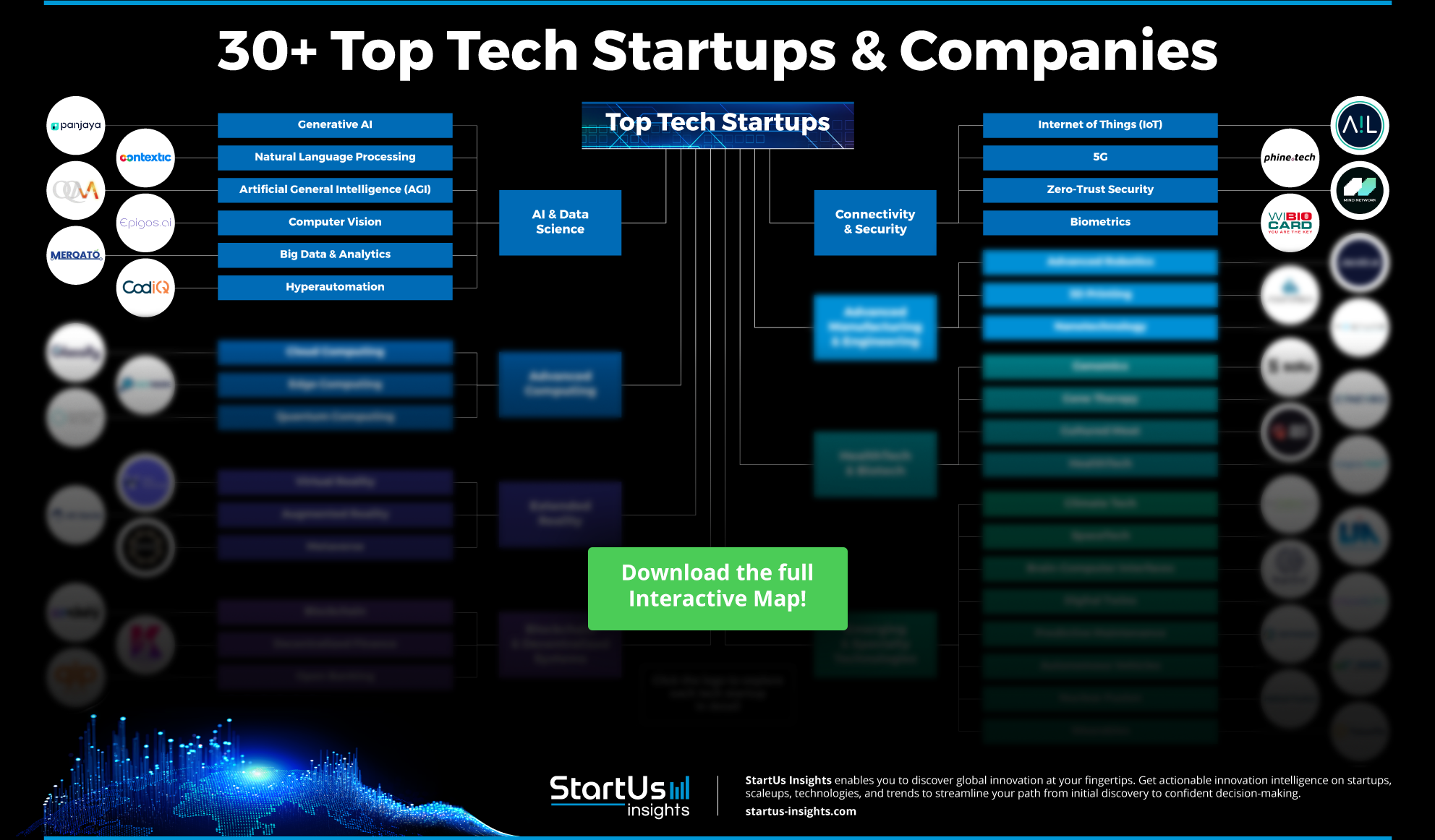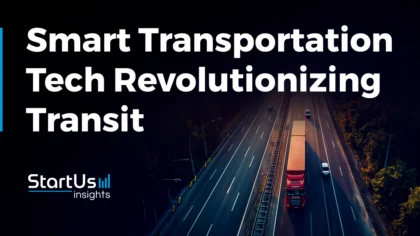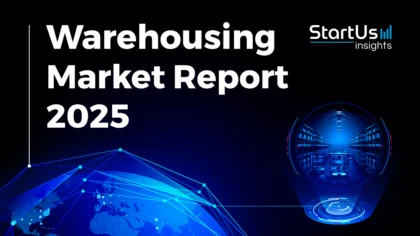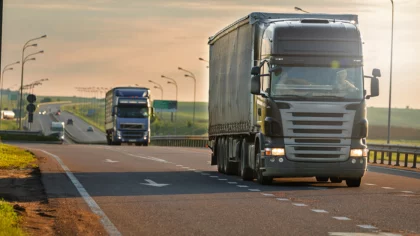Implementation of emerging technologies like artificial intelligence (AI), Internet of Things (IoT), blockchain, and more are addressing immediate challenges in the transportation sector including urban congestion and carbon emissions. As smart transportation evolves, these technologies create more efficient and connected transit systems. Startups like Circuits Evolved leverage AI-powered traffic management systems to optimize urban mobility, reducing wait times and emissions at intersections.
Meanwhile, cleantech startups, like Tubular Network, improve logistics with decarbonized, automated transportation systems that integrate into existing infrastructures. Big data, connectivity technologies, and blockchain further enhance transparency and efficiency in supply chains, while AR, VR, and biometrics improve user experience and security. With cloud computing enabling scalable solutions, the future of transportation promises smarter, safer, and more sustainable systems. This article explores the latest advancements, offering valuable insights for industry experts keen to navigate and capitalize on these transformative trends.
Why should you read this report?
- Gain insights into the top 10 techn impacting transportation.
- Learn about three practical use cases for each technology.
- Meet 10 innovative startups advancing these technologies.

Key Takeaways
- Artificial Intelligence
- Use Cases:
- Traffic Management & Analysis
- Predictive Maintenance
- Autonomous Vehicles
- Startup to Watch: Circuits Evolved
- Use Cases:
- Advanced Robotics
- Use Cases:
- Automated Warehousing
- Drone Delivery
- Robotic Maintenance
- Startup to Watch: Alpha Asimov
- Use Cases:
- Internet of Things
- Use Cases:
- Smart Traffic Systems
- Connected Vehicles
- Asset Tracking
- Startup to Watch: Helgg
- Use Cases:
- CleanTech
- Use Cases:
- Electric Vehicles
- Sustainable Fuel Alternatives
- Energy-efficient Operations
- Startup to Watch: Tubular Network
- Use Cases:
- Big Data & Analytics
- Use Cases:
- Fleet Management
- Passenger Behavior Analysis
- Safety Analysis
- Startup to Watch: TransiTool
- Use Cases:
- Connectivity Technologies
- Use Cases:
- V2V Communication
- Real-time Passenger Information Systems
- 5G Implementation
- Startup to Watch: AI-LINK
- Use Cases:
- Blockchain
- Use Cases:
- Supply Chain Transparency
- Automated Transactions
- Secure Ticketing Systems
- Startup to Watch: Prometeo Chain System
- Use Cases:
- Augmented Reality & Virtual Reality
- Use Cases:
- Training & Simulations
- Navigation Systems
- VR-driven Design and Testing
- Startup to Watch: eLogistApp
- Use Cases:
- Biometrics
- Use Cases:
- Secure Vehicle Access
- Identity Verification
- Customized Travel Experiences
- Startup to Watch: Ixion
- Use Cases:
- Cloud Computing
- Use Cases:
- Real-time Data Access
- Infrastructure Management
- On-demand Service Delivery
- Startup to Watch: Sfey
- Use Cases:
Transportation Industry FAQs
Is the transportation industry growing?
The transportation industry is growing steadily, with a projected global market value of over USD 15 trillion by 2032, reflecting a compound annual growth rate (CAGR) of 8.11% from 2023 to 2032. The industry is benefiting from increased demand for goods, particularly driven by e-commerce and global supply chain shifts. Nearshoring and reshoring trends are also expected to reshape the industry’s landscape, with more companies relocating manufacturing closer to major markets like the US and Europe.
What are the challenges facing transportation?
Fluctuating fuel prices continue to strain profit margins for transportation companies. The industry also faces a persistent driver shortage, with the American Trucking Associations (ATA) estimating a deficit of about 160000 drivers by 2030. Further, geopolitical instability, natural disasters, and regulatory changes related to emissions and sustainability create an unpredictable environment for transportation companies.
Where We Get Our Data From
StartUs Insights gathers data through its exhaustive Discovery Platform, covering information on 4.7 million startups, scaleups, and tech companies globally, alongside 20000 emerging technologies and trends. The Discovery Platform accelerates startup and technology scouting, trend intelligence, and patent searches, offering thorough insights into technological advancements. By leveraging the trend intelligence feature for this report, we identified emerging technologies within specific industries. This process allows us to uncover patterns and trends, and pinpoint relevant use cases and the startups creating solutions for each scenario. Additional capabilities and information can be found at StartUs Insights Discovery Platform.
10 Emerging Technologies Impacting the Future of Transportation Industry [2025 & Beyond]
1. Artificial Intelligence

Artificial Intelligence (AI) is advancing transportation by addressing challenges like traffic congestion, safety, and operational inefficiencies. AI solutions, including predictive maintenance, intelligent traffic management, and autonomous driving, enhance urban mobility and logistics. Predictive maintenance minimizes downtime, while intelligent traffic systems optimize flow and reduce congestion. Autonomous driving improves safety by reducing human error. AI also boosts fleet management efficiency, contributing to more sustainable and smarter urban transportation networks.
3 Practical Use Cases of AI in Transportation
- Traffic Management & Analysis: AI optimizes traffic flow by analyzing real-time data from sensors and cameras, which enables adaptive traffic signal control and reduces congestion. It also identifies traffic patterns and potential bottlenecks to provide data-driven insights and enhance urban mobility planning.
- Predictive Maintenance: Leveraging machine learning algorithms, companies analyze vehicle sensor data, identify wear and tear before failures occur, and reduce downtime. AI also optimizes maintenance schedules, ensuring timely interventions that prolong the lifespan of transportation assets and improve operational efficiency.
- Autonomous Vehicles: AI integrates computer vision, sensor fusion, and decision-making algorithms to drive autonomous vehicles. This allows for safe navigation and real-time response to dynamic road conditions.
Startup to Watch: Circuits Evolved
US-based startup Circuits Evolved develops an AI-powered CircuitFlow Controller to build intelligent traffic solutions for optimizing urban mobility. The CircuitFlow system integrates with existing traffic infrastructure, offers traffic control, and reduces intersection wait times. The company’s product cuts emissions at intersections and enhances safety through preemptive hazard detection by adjusting traffic lights to prevent collisions. It also offers advanced data collection tools for city planners. Circuits Evolved creates smarter, more efficient, and safer urban environments, to transform how cities manage traffic and reduce their environmental impact.
2. Advanced Robotics

The advancements in AI and machine learning are making robots more autonomous and capable of handling complex tasks with minimal human intervention. Autonomous mobile robots (AMRs) are increasingly being deployed in logistics and warehouse management to optimize material handling and last-mile delivery processes. Further, collaborative robots, or cobots, work alongside human workers, reducing the physical strain of repetitive tasks and improving overall productivity.
3 Practical Use Cases of Robotics in Transportation
- Automated Warehousing: Robotics automates warehousing by enabling robots to handle tasks like sorting, packing, and moving goods with speed and precision, reducing human error and labor costs. These systems optimize storage efficiency and streamline logistics, ensuring faster order fulfillment and improved inventory management in transportation hubs.
- Drone Delivery: Drone delivery systems automate the transportation of goods to customers, bypassing traffic and reducing delivery times, particularly in urban areas. These drones are equipped with navigation and obstacle-avoidance technologies, enabling efficient delivery of packages to remote or congested locations.
- Robotic Maintenance: Robotic systems inspect, repair, and maintain vehicles, infrastructure, and equipment in the transportation sector. These robots perform complex tasks like welding, painting, and diagnostics in hard-to-reach areas, improving the safety and efficiency of maintenance operations.
Startup to Watch: Alpha Asimov
Vietnamese startup Alpha Asimov develops autonomous food delivery robots for urban environments. Its robots use AI, sensors, cameras, and sonars for obstacle detection and avoidance and ensure secure and efficient package delivery. The compact design allows the robots to move through busy streets, while the lithium-ion battery supports a maximum speed of 15 km/h, making them eco-friendly. Alpha Asimov’s solution reduces missed deliveries and enhances the overall customer experience.
3. Internet of Things

Through the integration of IoT sensors and devices, transportation systems monitor real-time data on vehicle performance, traffic conditions, and shipment status. This leads to optimized routes, reduced fuel consumption, and improved asset management. IoT also enables predictive maintenance, aiding companies in preventing equipment failures and minimizing downtime.
3 Practical Use Cases of IoT in Transportation
- Smart Traffic Systems: IoT-based traffic systems connect traffic lights, sensors, and cameras, enabling dynamic traffic flow management and reducing congestion. These systems collect and analyze real-time data, allowing cities to optimize signal timing, monitor traffic conditions, and respond quickly to incidents.
- Connected Vehicles: IoT enables connected vehicles to communicate with each other and with infrastructure. It enhances safety, efficiency, and driving experiences through real-time data exchange. This connectivity allows vehicles to access up-to-date traffic information, monitor vehicle health, and support features like autonomous driving and advanced driver assistance systems (ADAS).
- Asset Tracking: Equipping vehicles, cargo, and equipment with sensors provides real-time location and condition data and improves tracking. This technology enhances supply chain visibility, reduces losses, and enables more efficient management of transportation assets through continuous monitoring and data-driven decision-making.
Startup to Watch: Helgg
Nigerian startup Helgg creates an interconnected e-transport network that offers sustainable transportation options across African cities, including electric bicycles, electric scooters, and electric cars. Utilizing IoT technology, the company ensures connectivity and efficient management of its vehicles, which are powered by rechargeable batteries. Through the Helgg Mobile app, users unlock vehicles, scan QR codes, and make payments via Helgg Virtual wallet. The company provides zero-emission transportation options to reduce carbon footprints while offering an affordable and efficient alternative to traditional transport.
4. CleanTech

Cleantech is driving the transition toward sustainability and reducing the transportation sector’s environmental impact. From electric vehicles (EVs) to hydrogen fuel cells and advanced battery technologies, cleantech innovations are pivotal in decarbonizing transportation. These technologies lower greenhouse gas emissions and enhance energy efficiency, making transportation cleaner and more cost-effective.
3 Practical Use Cases of CleanTech in Transportation
- Electric Vehicles: Cleantech accelerates electric vehicle adoption by enhancing battery technology and charging infrastructure. This supports the transition to greener transportation by increasing EV range, efficiency, and accessibility.
- Sustainable Fuel Alternatives: The development of sustainable fuel alternatives, such as biofuels and hydrogen, reduce carbon emissions and environmental impact. These alternatives offer a renewable and cleaner energy source, aiding to decarbonize industries like aviation, shipping, and heavy-duty transport.
- Energy-efficient Operations: Integrating smart technologies reduces energy consumption across logistics, fleet management, and infrastructure. Innovations like regenerative braking, energy-efficient routing, and electrified public transport systems contribute to lower operational costs and a smaller carbon footprint.
Startup to Watch: Tubular Network
US startup Tubular Network builds a decarbonized transportation system that automates the movement of goods through a 3D tubular network. The company’s AI-driven electric shuttles travel within interconnected tubes, providing efficient and sustainable delivery by integrating with existing logistic infrastructures. Its real-time tracking software coordinates point-to-point delivery and ensures speed. Tubular Network’s eco-friendly solution enhances logistic efficiency while supporting urban sustainability goals.
5. Big Data & Analytics

Transportation companies are optimizing routes, reducing fuel consumption, and predicting maintenance needs with accuracy by utilizing vast datasets from GPS tracking, IoT sensors, and transaction logs. Big data & analytics allow for real-time insights and predictive analytics that allow companies to proactively address potential disruptions and streamline operations. Further, these technologies enhance demand forecasting, enabling businesses to better anticipate market trends and customer needs.
3 Practical Use Cases of Big Data & Analytics in Transportation
- Fleet Management: Transportation startups leverage big data & analytics to analyze vehicle performance, fuel consumption, and route efficiency. It allows them to reduce costs and improve resource allocation in fleet management.
- Passenger Behavior Analysis: Big data and analytics provide insights into passenger behavior by analyzing travel patterns, preferences, and demographics. This approach aids transportation providers to optimize routes, schedules, and capacity to meet passenger demand.
- Safety Analysis: Leveraging big data & analytics enables processing data from sensors, cameras, and accident reports to identify risk factors and prevent incidents. It also supports the development of predictive models that anticipate safety issues, enabling proactive measures and improving transportation safety.
Startup to Watch: TransiTool
Greek startup TransiTool builds a transit data management and analytics platform to optimize public transportation systems. The platform enables transportation providers to collect, analyze, and manage transit data through tools like data standardization, APIs, and real-time analytics. TransiTool Analytics allows them to assess service performance using public transport accessibility levels (PTAL) and local index of transit availability (LITA) metrics, disambiguate results, and improve networks to increase patronage. Further, the startup’s route matching and travel mode detection features enhance route usage estimation, support mode-based services, and smart ticketing, and improve advertisement income projections.

6. Connectivity Technologies

Connectivity technologies enable real-time communication, enhance safety, and improve operational efficiency in the transportation industry. The integration of satellite, mobile networks, and Wi-Fi 7 into hybrid solutions is transforming how vehicles and infrastructure interact, ensuring connectivity even in remote areas. These technologies support a range of applications, from autonomous driving to passenger entertainment systems, all while optimizing resource usage and reducing costs for transportation operators.
3 Practical Use Cases of Connectivity Technologies in Transportation
- V2V Communication: Connectivity technologies enable vehicle-to-vehicle (V2V) communication, allowing vehicles to exchange real-time data on speed, position, and road conditions, improving safety and traffic flow. This system reduces the likelihood of accidents by providing advanced warnings of potential hazards and facilitating coordinated driving among connected vehicles.
- Real-Time Passenger Information Systems: WiFi and cellular networks allow public transit systems to provide passengers with real-time updates on arrival times, service disruptions, and route changes. These systems display information on digital screens at stations and stops, as well as through mobile apps, ensuring that passengers are informed and make timely decisions about their travel plans.
- 5G Implementation: 5G enables ultra-fast, low-latency communication between vehicles, infrastructure, and cloud services. This implementation supports applications like autonomous driving, real-time traffic management, and enhanced passenger experiences.
Startup to Watch: AI-LINK
Chinese startup AI-LINK provides a last-mile communication solution for warehouse logistics through its Industrial Private 5G Network. This technology facilitates real-time data transmission and connectivity between autonomous robots, sensors, and other industrial devices within warehouse environments. The startup’s technology ensures high-speed connectivity by integrating a 5G core network with Industrial Edge Intelligence.
7. Blockchain

Blockchain enhances transparency, security, and efficiency across the transportation supply chain. This decentralized technology enables the creation of immutable records that track goods from origin to destination, reducing errors and fraud. With smart contracts automating transactions, blockchain simplifies payments, customs clearance, and regulatory compliance, speeding up operations.
3 Practical Use Cases of Blockchain in Transportation
- Supply Chain Transparency: Blockchain provides an immutable and decentralized ledger, allowing stakeholders to track the movement of goods in real-time. This ensures transactions and changes in the supply chain are securely recorded, reducing fraud and improving trust among manufacturers, logistics providers, retailers, and more.
- Automated Transactions: Smart contracts execute payments and agreements automatically when predefined conditions are met. It reduces the need for intermediaries, speeds up transaction processes, and ensures accuracy and security in financial dealings across the transportation network.
- Secure Ticketing Systems: Blockchain in ticketing systems creates tamper-proof digital tickets that are verified and transferred between parties. This technology prevents ticket fraud and ensures that passengers confidently purchase and use transportation tickets with traceability and security.
Startup to Watch: Prometeo Chain System
Kazakhstan-based startup Prometeo Chain System provides blockchain-powered platforms that enhance supply chain transparency in transportation. Its Ikarus Network tracks and records every transaction, offering real-time visibility across the entire supply chain. The Ikarus Way module integrates data from multiple logistics partners and optimizes route management. Further, the Ikarus Stock platform provides detailed inventory management, allowing stakeholders to monitor stock levels and movement. Ikarus Trust also strengthens supply chain credibility by validating data integrity and certifying compliance with industry standards.
8. Augmented Reality & Virtual Reality

In the transportation industry, Augmented Reality (AR) and Virtual Reality (VR) are changing various aspects of logistics, navigation, and customer engagement. AR and VR technologies enable immersive and interactive experiences, such as real-time data overlay for navigation, immersive driver training simulations, and advanced warehouse management solutions. These innovations enhance operational efficiency and safety while reducing costs and errors. Moreover, the integration of AR into transportation systems improves vehicle maintenance, guiding technicians in repairs and diagnostics.
3 Practical Use Cases of AR & VR in Transportation
- Training & Simulations: AR and VR transform training by creating immersive, realistic simulations for pilots, drivers, and operators, enhancing skill acquisition and safety. These technologies also allow trainees to experience complex scenarios in a controlled environment, reducing risks and improving overall preparedness.
- Navigation Systems: AR enhances navigation systems by overlaying real-time directions and points of interest on the driver’s view, improving route accuracy and situational awareness.
- VR-driven Design and Testing: VR-driven design and testing allow transportation engineers to create and evaluate vehicle prototypes in a virtual environment, reducing the time and costs associated with physical modeling. This transport tech enables comprehensive testing of design features and ergonomics, ensuring optimal functionality and user experience before production.
Startup to Watch: eLogistApp
Ukrainian startup eLogistApp provides a delivery system with an AR measurement engine to enhance logistics. The system integrates AR to measure and optimize parcel dimensions, ensuring accurate logistics planning. Its video object verification technology enables end-clients to verify parcels or moving objects, providing logistic providers with exact volume data at the estimation stage. The company offers third-party API integration, a logistic CRM, and an end-client app, which streamline delivery operations. eLogistApp minimizes errors in parcel handling, increases efficiency, and reduces costs.
9. Biometrics

Biometrics is emerging as a critical technology in the transportation industry, enhancing security and efficiency. It utilizes unique biological characteristics such as fingerprints, facial recognition, and iris scans, to identity verification processes for passengers and employees. This transportation technology is particularly impactful in airports, ride-sharing services, and public transit systems, where quick and reliable identity checks are essential for safety and operational smoothness.
3 Practical Use Cases of Biometrics in Transportation
- Secure Vehicle Access: By using fingerprint, facial recognition, or iris scanning technology, biometrics ensures that only authorized individuals operate the vehicle. This technology in transportation reduces the risk of theft and enhances security through unique biological identifiers.
- Identity Verification: Biometrics streamline identity verification in transportation hubs by using facial recognition or fingerprint scanning for quick and accurate passenger identification, reducing boarding time. It also integrates with ticketing and border control systems to ensure secure travel experiences across various modes of transportation.
- Customized Travel Experiences: Facial recognition technology enhances personalized travel experiences by identifying passengers in real-world environments and adapting services based on their biometric profiles. Transportation companies and hotels match faces to those in a database, allowing for tailored services.
Startup to Watch: Ixion
Turkish startup Ixion develops a smart transportation card with biometric verification to streamline public transit processes. The card integrates fingerprint recognition that allows passengers to authenticate themselves without sharing personal data. This digitizes the verification process, reducing the need for manual checks and improving efficiency in transit operations. This way, Ixion’s solution creates a more secure and efficient transportation system for transit providers and passengers.
10. Cloud Computing

By leveraging cloud-based platforms, transportation companies streamline processes like fleet management, logistics planning, and passenger services without the need for on-premise infrastructure. This allows for real-time tracking, predictive maintenance, and optimized route planning, thereby reducing delays and improving overall service quality.
3 Practical Use Cases of Cloud Computing in Transportation
- Real-time Data Access: Cloud computing enables real-time data access in transportation by allowing vehicles and infrastructure to continuously upload and analyze data, improving decision-making and response times. This enhances traffic management, fleet operations, and passenger services.
- Infrastructure Management: Leveraging the cloud streamlines infrastructure management and centralizes control over transportation systems. It enables remote monitoring, maintenance, and optimization of assets such as roads, bridges, and public transport. This reduces operational costs and enhances the efficiency of managing large-scale transportation networks.
- On-demand Service Delivery: Transportation platforms use cloud technology to offer ride-sharing, vehicle rentals, and other related services with real-time booking, payment, and tracking features. It also enables scaling of services to meet fluctuating demand, ensuring efficient resource allocation and enhanced customer satisfaction.
Startup to Watch: Sfey
Estonian startup Sfey provides a cloud-based transit gateway that enables contactless payments for public transportation systems. The platform allows passengers to use contactless cards or mobile wallets to pay for rides. Its transit module enhances payment processes by streamlining debt recovery management, whitelist and blacklist management, and payment window configuration. The module also supports advanced token management, including PAR and FPAN tokens, for secure wallet transactions. Further, it processes taps from validators, issues authorization, and card verification requests, tracks transaction limits for aggregated taps, and manages settlement for the aggregation period. By supporting various transportation modes, including buses, trams, and metros, Sfey’s solution creates a more efficient, sustainable, and economically viable urban mobility network.
Outlook for the Transportation Industry
Patents & Grants
Innovation and research development are central to this sector, as evidenced by over 155000 patents and more than 14000 grants.
For more actionable insights, download our free Transportation Innovation Report.
Investment Landscape
Investment in the industry remains strong, with an average investment value of USD 13.1 million per round. Among the top investors are EIT Urban Mobility, Techstars, Prequel Ventures, Antler, and Cleantech Open, which have played significant roles in shaping the sector’s growth. The most common funding types include seed, early-stage VC/series A, pre-seed, angel, and equity crowdfunding.
Global Footprint
Key hubs such as the US, Germany, the UK, India, and France, along with major cities like London, New York City, and Singapore, play pivotal roles in the global transportation landscape.
Don’t Miss Out on the Latest Transportation Innovations
Ready to leverage the latest transportation technologies shaping the future? With StartUs Insights, you gain quick and easy access to over 4.7 million startups, scaleups, and tech companies, along with 20,000 emerging technologies and trends. Our AI-powered search and real-time database provide exclusive solutions that set you apart from the competition.
Industry giants like Samsung, Nestlé, and Magna trust our innovation intelligence tools to lead trends, optimize operations, and uncover new market opportunities. Boris Hueske, Head of Digital Transformation at Lufthansa Cargo, says, “The StartUs Insights Discovery Platform is a great tool to scout global startups & scaleups. It allows us to find the solutions that matter to us.”
Like them, you can benefit from our unmatched data, comprehensive industry views, and reliable insights to drive strategic decision-making. Get in touch to learn how our tailored discovery options can accelerate your innovation journey.
Discover Transportation Technologies & Startups!








